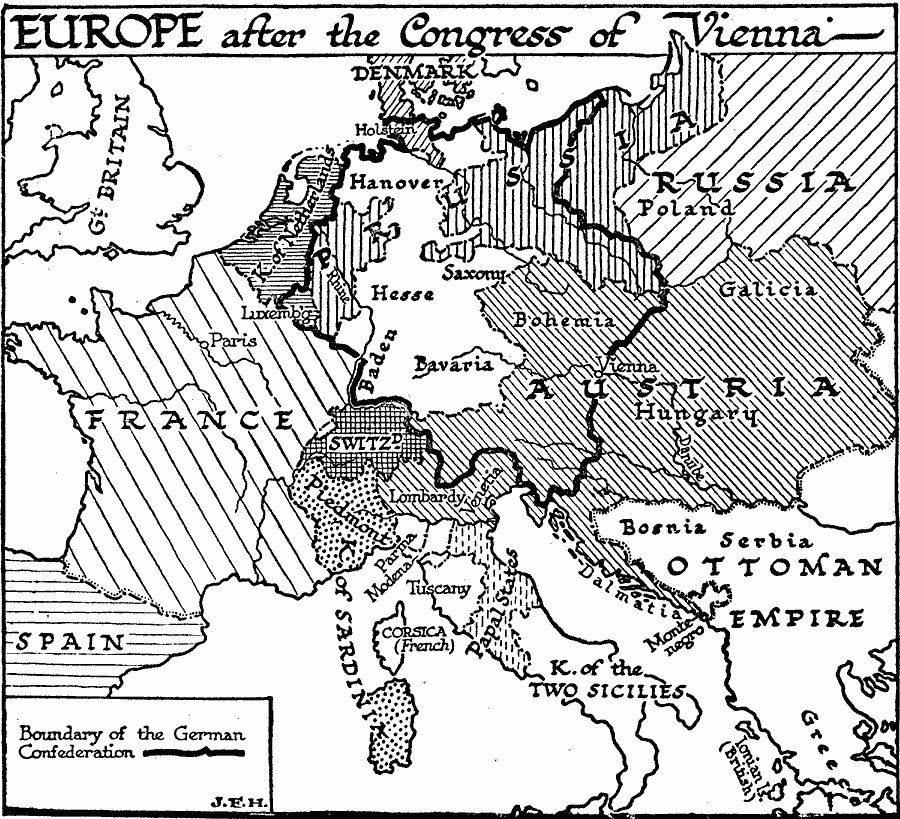Revolutionary Europe (1820-1848)
The Congress System broke up because France and Britain were in total disagreement with Russia, Austria and Prussia. After 1815 the great powers never met again.
Nationalism, liberalism and socialism became the major influences which help us to understand the revolutionary processes along the period which started in 1820.
Liberal and nationalist revolutions of 1820
In 1820 the first liberal revolution broke out in Spain. The liberals rebelled, under the initiative of a general called Rafael Riego, and managed to force the absolute king, Fernando VII, who had rejected the liberal constitution which had been previously passed in 1812, to accept the popular sovereignty which was represented by this former legal document. For three years the liberals governed Spain, until French troops intervened militarly in 1823 making the revolution to fail.
Rafael Riego, a liberal general
Shortly after the Spanish revolution, a liberal revolution in Portugal succeeded and a constitutional government was created. This wouldn't have been possible without an army the British sent in order to make sure that the revolt had success.
In Latin America the subjects of the kings of Spain and Portugal rebelled in order to obtain their independence. Spanish colonies were lost in Latin America, with the exception of Cuba and Puerto Rico.
In Latin America the subjects of the kings of Spain and Portugal rebelled in order to obtain their independence. Spanish colonies were lost in Latin America, with the exception of Cuba and Puerto Rico.
The members of the Holy Alliance tried to intervene but they met the hostility by the British and the USA president, James Monroe, who declared, in his famous Doctrine of 1823, that any interference by European powers in the affairs of the American continent would be regarded "as the manifestation of an unfriendly disposition to the United States"; in other words, an act of war.
The last revolution of the decade was the Greek. These people rebelled against the Ottoman Turks. For several years the Greeks had been fighting for their independence from the Ottoman Empire, and finally they obtained it in 1827, thanks to the support of different nations: France, Britain and Russia. In 1832 the European major nations recognized Greece as an independent sovereign state.Revolutions of 1830
In France the population revolted against the absolute Bourbon monarch, Charles X who had published four ordinances dissolving the Chamber of Deputies, suspended freedom of the press, modified the electoral laws so that three-fourths of the electorate lost their votes, and called for new elections to the Chamber in September. Strikes and protests were followed by armed confrontations. The royal forces were unable to contain the insurrection and, after three days of fighting (July 27–29) Charles X was replaced by another king, Louis-Philippe d'Orléans, who had fought for the French Republic in 1792.
The French example was followed in many parts of Europe in the same year but most liberals throughout Europe were disappointed in their expectations of a radical, social change since the other revolts were supressed harshly.
In Poland, people revolted against the Russian Tsar, but their revolt was cruelly suppressed and Poland was incorporated into the Russian Empire.
Belgium declared its independence from the Netherlands, and it was recognized in 1831 as an independent nation.
The Italian and German nationalist and liberal revolts were cruelly ended.
Revolutions of 1848
This year was known as the Spring of Nations or the Year of the Revolution.
The period of unrest began in France and then, further propelled by the French Revolution of 1848, soon spread to the rest of Europe.
In Paris middle class elements demanding the vote were joined by workers demanding an end to their explotation. King Louis Philippe fled into the exile and his constitutional monarchy was substituted by the French Second Republic. This government was headed by Louis-Napoleon who, after only four years, returned France to a monarchy with the establishment of the Second French Empire in 1852.
The French was the only revolution in 1848 which was successful.
Other revolutions:
a) Liberal (Vienna)
b) Nationalist (Hungary, Bohemia, North of Italy, German states)
The years 1815 to 1848 have often been called "the years of Metternich". Klemens von Metternich was the Austrian chancellor at this period and he was, without doubt, the greatest statesman in Europe. His ambition had been to destroy all traces of revolutionary change in Europe introduced since 1789. He was the arch-conservative who was violently opposed to any kind of reform and who succeeded in imposing his ideas on the rest of Europe, helped by the Holy Alliance.
He realised that if the liberal and nationalist demands were met, and the people of Europe were given the chance to freely choose the country in which they lived and the type of government that ruled them, then the Austrian Empire was finished. Until 1848, he had largely succeeded, but, in that year, when Hungary had risen in revolt and Austrian students had demonstrated in the streets of Vienna demanding "Down with Metternich!", the emperor dismissed him.
Activities:
1) Why do you think that France crushed the first Spanish liberal revolution in 1823?
2) Comment on the following quote by the USA President, James Monroe:
“The American continents ... are henceforth not to be considered as subjects for future colonization by any European powers”.
3) Comment on the following quote by Von Metternich:
“ Italy is only a geographical expression”
4) Why did the French, who already had a constitutional monarchy, rebel, in 1848, against their monarch, who, besides, had defended the revolutionary principles actively in 1792?
Extra, voluntary task:





